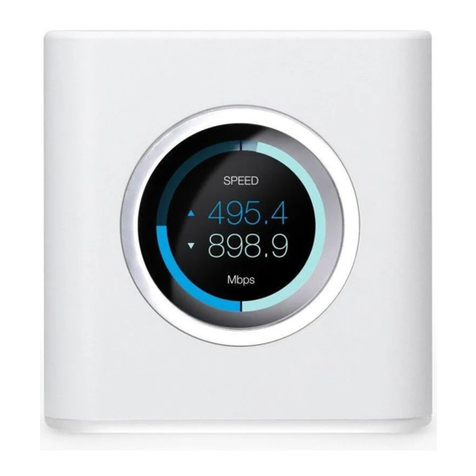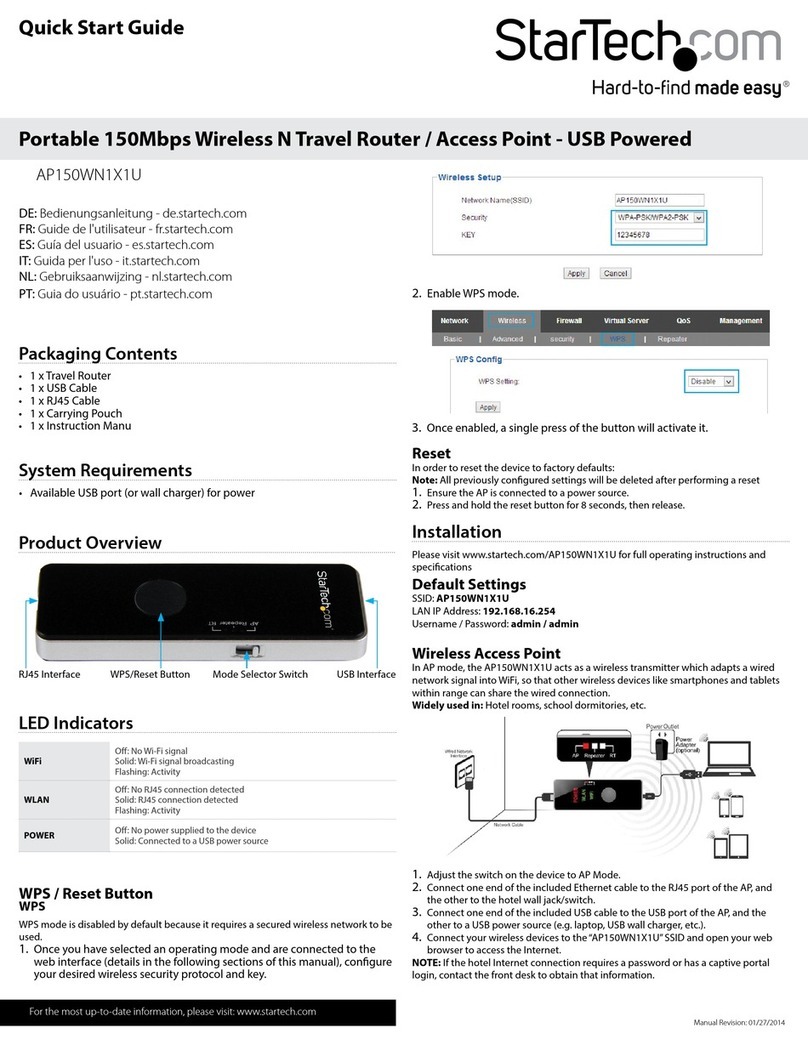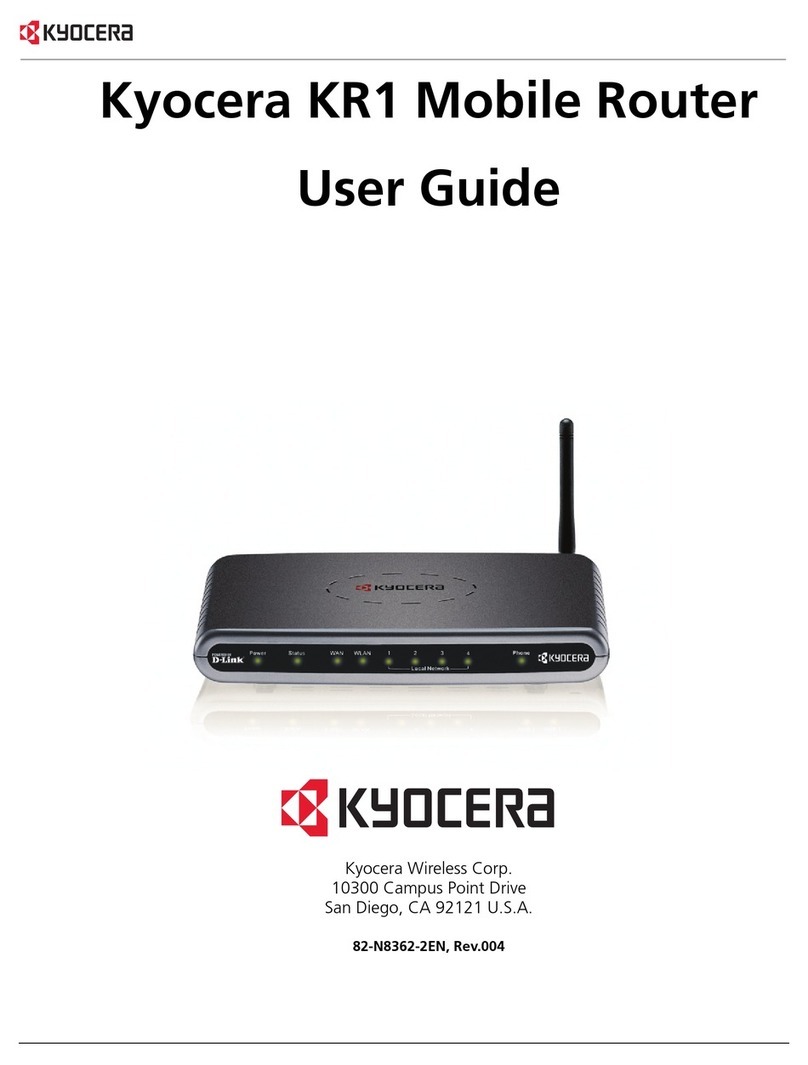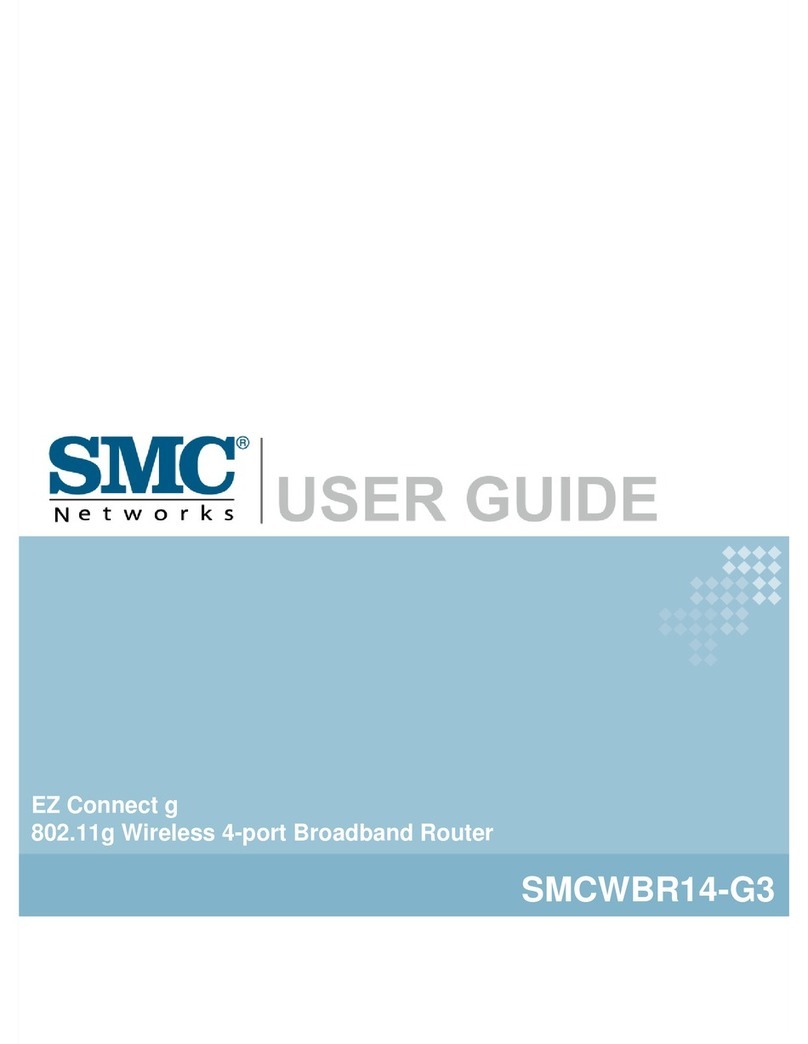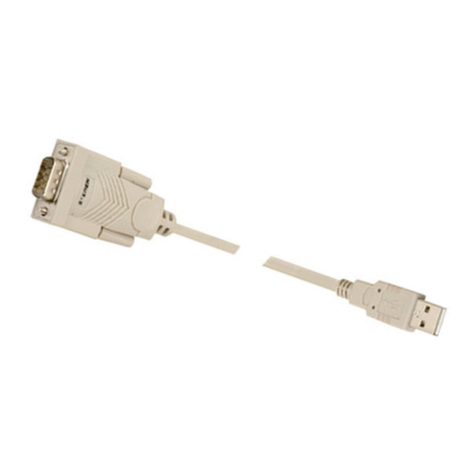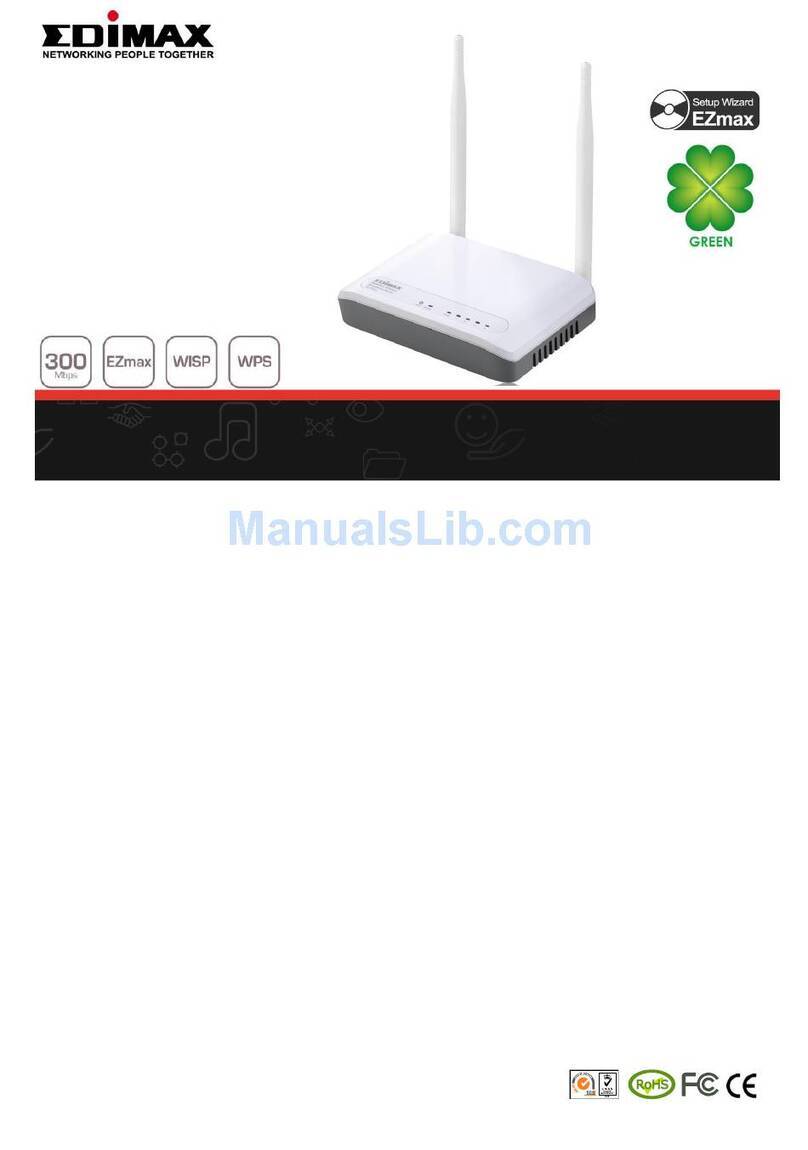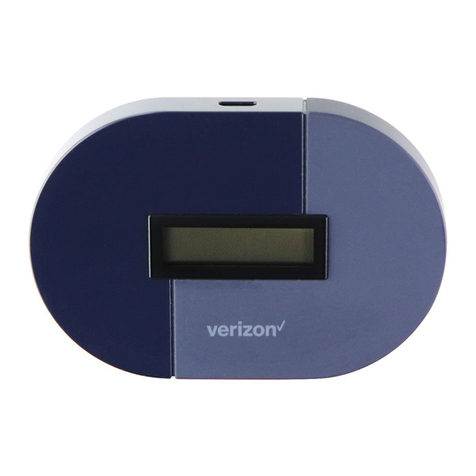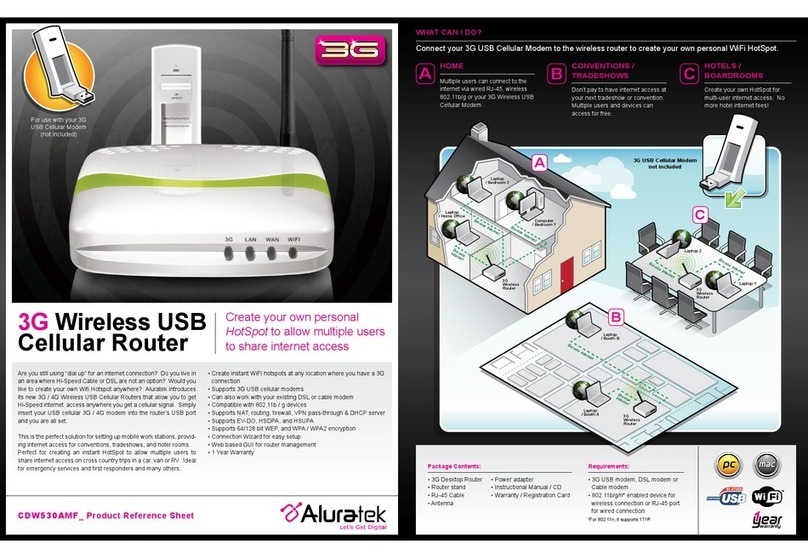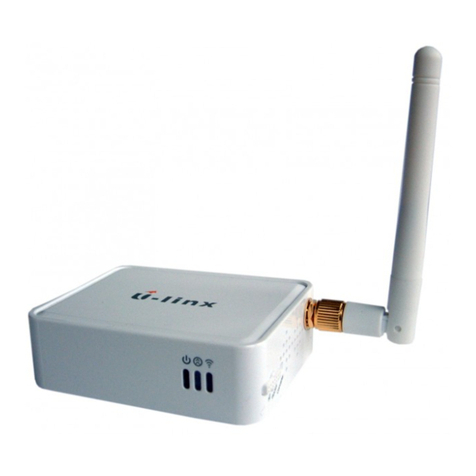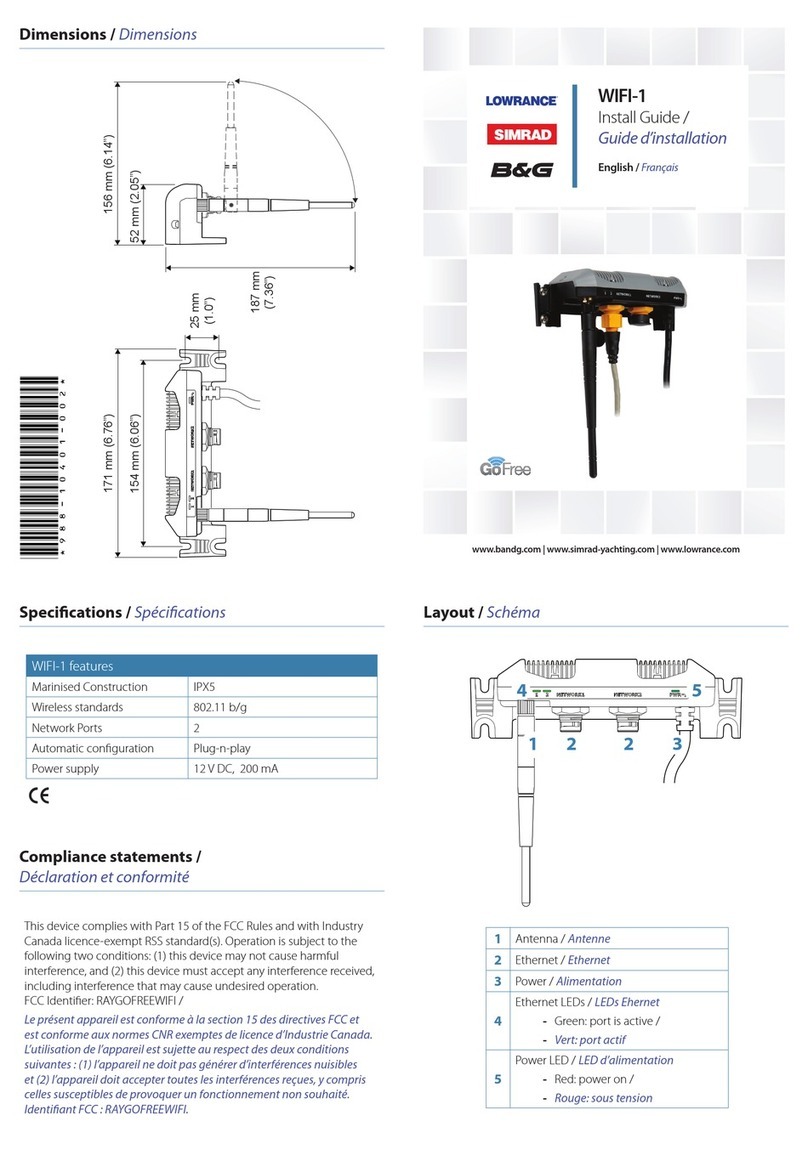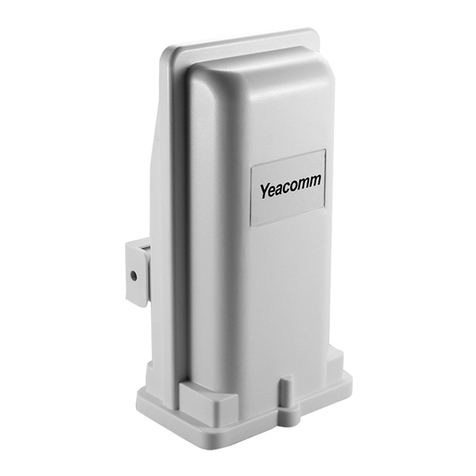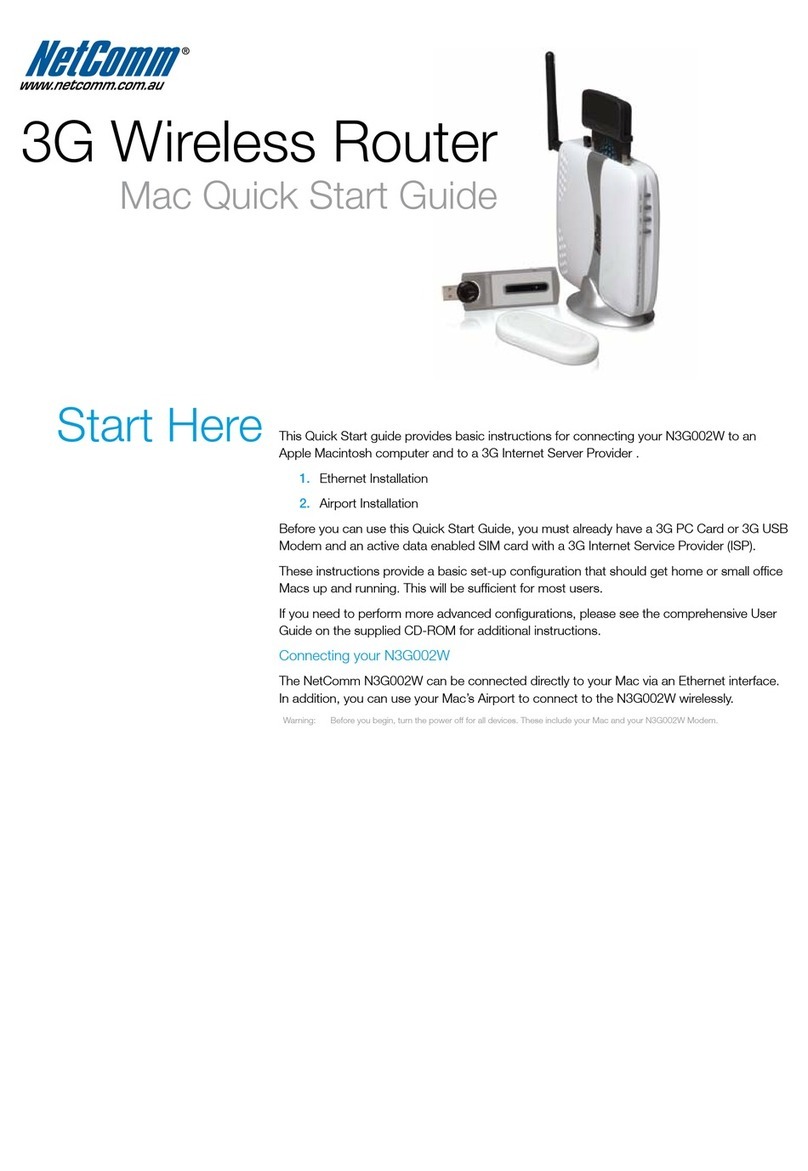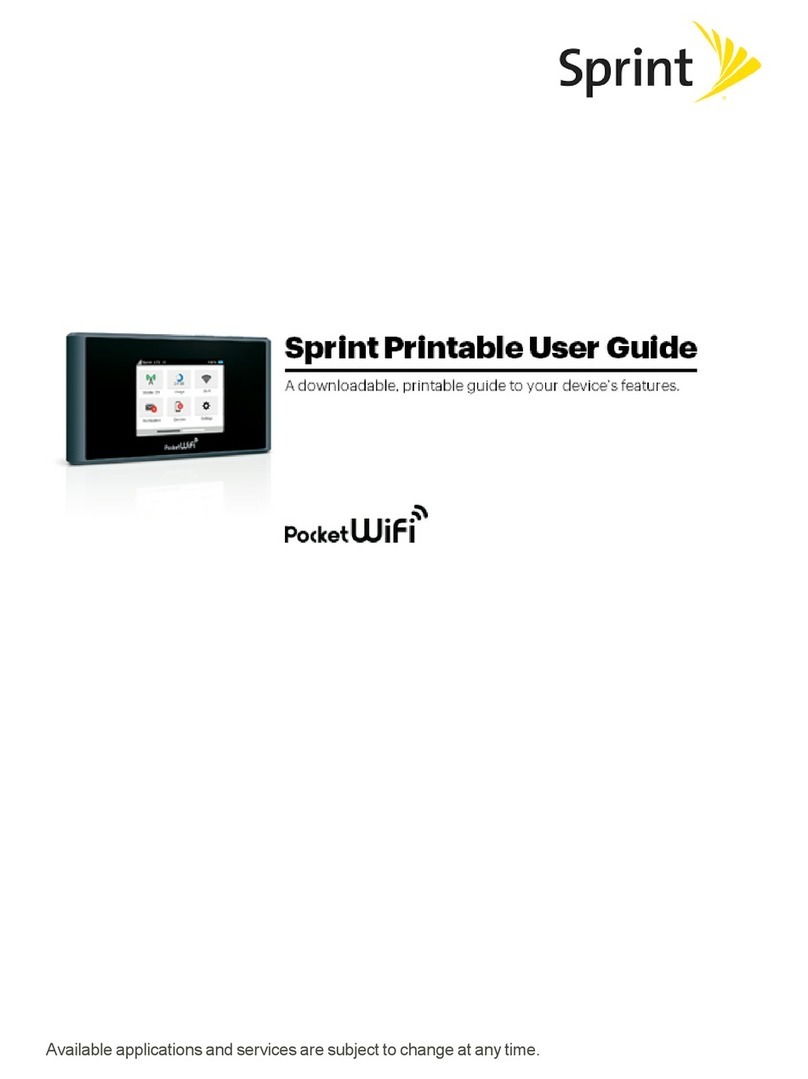Gigaset Gigaset SE555 WLAN dsl User manual

Gigaset SE555 WLAN dsl / en / A31008-M1037-B181-1-7619 / cover_front.fm / 27.06.2006
Schablone 2004_08_26
First steps

II
Gigaset SE555 WLAN dsl / en / A31008-M1037-B181-1-7619 / cover_front.fm / 27.06.2006
Schablone 2004_08_26

1
Contents
Gigaset SE555 WLAN dsl / en / A31008-M1037-B181-1-7619 / SE555_WLAN_dslIVZ.fm / 27.06.2006
Schablone 2004_08_26
Contents
Safety precautions . . . . . . . . . . . . . . . . . . . . . . . . . . . 5
The Gigaset SE555 WLAN dsl . . . . . . . . . . . . . . . . . . 6
Local area networks with Gigaset products . . . . . . . . . . . . . . . . . . . . . . . . . . . . . . . . . . 7
Wired local area network (Ethernet) . . . . . . . . . . . . . . . . . . . . . . . . . . . . . . . . . . . . 8
Wireless local area network (WLAN) . . . . . . . . . . . . . . . . . . . . . . . . . . . . . . . . . . . . 9
Linking a wireless local area network (WLAN) to an Ethernet (LAN) . . . . . . . . . . 11
Extending the wireless network coverage with a repeater . . . . . . . . . . . . . . . . . . 12
Features and applications . . . . . . . . . . . . . . . . . . . . . . . . . . . . . . . . . . . . . . . . . . . . . . 13
First steps . . . . . . . . . . . . . . . . . . . . . . . . . . . . . . . . . 15
Contents . . . . . . . . . . . . . . . . . . . . . . . . . . . . . . . . . . . . . . . . . . . . . . . . . . . . . . . . . . . . 15
System requirements . . . . . . . . . . . . . . . . . . . . . . . . . . . . . . . . . . . . . . . . . . . . . . . . . . 15
Overview of the installation steps . . . . . . . . . . . . . . . . . . . . . . . . . . . . . . . . . . . . . . . . 16
Setting up the Gigaset SE555 WLAN dsl . . . . . . . . . . . . . . . . . . . . . . . . . . . . . . . . . . . 17
Connecting and activating the Gigaset SE555 WLAN dsl . . . . . . . . . . . . . . . . . . . . . . 18
Ports on the rear panel . . . . . . . . . . . . . . . . . . . . . . . . . . . . . . . . . . . . . . . . . . . . . 18
Connecting to the splitter data port . . . . . . . . . . . . . . . . . . . . . . . . . . . . . . . . . . . 19
Connecting to the PC . . . . . . . . . . . . . . . . . . . . . . . . . . . . . . . . . . . . . . . . . . . . . . . 19
Connecting to the mains power supply . . . . . . . . . . . . . . . . . . . . . . . . . . . . . . . . . 21
Switching on . . . . . . . . . . . . . . . . . . . . . . . . . . . . . . . . . . . . . . . . . . . . . . . . . . . . . 21
Checking the operating state . . . . . . . . . . . . . . . . . . . . . . . . . . . . . . . . . . . . . . . . . 22
Network configuration of the PCs . . . . . . . . . . . . . . . . . . . . . . . . . . . . . . . . . . . . . . . . 23
Making the basic settings . . . . . . . . . . . . . . . . . . . . . . . . . . . . . . . . . . . . . . . . . . . . . . 23
Connecting and configuring additional PCs (optional) . . . . . . . . . . . . . . . . . . . . . . . . 23
The user interface . . . . . . . . . . . . . . . . . . . . . . . . . . 24
Launching the user interface . . . . . . . . . . . . . . . . . . . . . . . . . . . . . . . . . . . . . . . . . . . . 24
The start screen . . . . . . . . . . . . . . . . . . . . . . . . . . . . . . . . . . . . . . . . . . . . . . . . . . . . . . 25
Selecting a language . . . . . . . . . . . . . . . . . . . . . . . . . . . . . . . . . . . . . . . . . . . . . . . . . . 27
Connecting to the Internet manually . . . . . . . . . . . . . . . . . . . . . . . . . . . . . . . . . . . . . 28
Elements on the user interface . . . . . . . . . . . . . . . . . . . . . . . . . . . . . . . . . . . . . . . . . . 29
Basic Setup Wizard . . . . . . . . . . . . . . . . . . . . . . . . . . 30
Regional Options . . . . . . . . . . . . . . . . . . . . . . . . . . . . . . . . . . . . . . . . . . . . . . . . . . . . . 31
Configuring Internet connections . . . . . . . . . . . . . . . . . . . . . . . . . . . . . . . . . . . . . . . . 32
Summary . . . . . . . . . . . . . . . . . . . . . . . . . . . . . . . . . . . . . . . . . . . . . . . . . . . . . . . . . . . 34

2
Contents
Gigaset SE555 WLAN dsl / en / A31008-M1037-B181-1-7619 / SE555_WLAN_dslIVZ.fm / 27.06.2006
Schablone 2004_08_26
Security Setup Wizard . . . . . . . . . . . . . . . . . . . . . . . 35
Assigning a password . . . . . . . . . . . . . . . . . . . . . . . . . . . . . . . . . . . . . . . . . . . . . . . . . 36
SSID . . . . . . . . . . . . . . . . . . . . . . . . . . . . . . . . . . . . . . . . . . . . . . . . . . . . . . . . . . . . . . . 37
Setting up security functions for the wireless network . . . . . . . . . . . . . . . . . . . . . . . . 38
WPA2/WPA with pre-shared key (PSK) . . . . . . . . . . . . . . . . . . . . . . . . . . . . . . . . . . 39
WEP encryption . . . . . . . . . . . . . . . . . . . . . . . . . . . . . . . . . . . . . . . . . . . . . . . . . . . 40
Access control within the wireless network . . . . . . . . . . . . . . . . . . . . . . . . . . . . . . . . 42
Saving settings . . . . . . . . . . . . . . . . . . . . . . . . . . . . . . . . . . . . . . . . . . . . . . . . . . . . . . . 43
Configuring Advanced Settings . . . . . . . . . . . . . . . 44
Internet . . . . . . . . . . . . . . . . . . . . . . . . . . . . . . . . . . . . . . . . . . . . . . . . . . . . . . . . . . . .45
Internet selection . . . . . . . . . . . . . . . . . . . . . . . . . . . . . . . . . . . . . . . . . . . . . . . . . . 46
Internet Connection . . . . . . . . . . . . . . . . . . . . . . . . . . . . . . . . . . . . . . . . . . . . . . . . 47
DNS server . . . . . . . . . . . . . . . . . . . . . . . . . . . . . . . . . . . . . . . . . . . . . . . . . . . . . . . 50
MAC Address . . . . . . . . . . . . . . . . . . . . . . . . . . . . . . . . . . . . . . . . . . . . . . . . . . . . . 51
Traffic Control . . . . . . . . . . . . . . . . . . . . . . . . . . . . . . . . . . . . . . . . . . . . . . . . . . . . 52
Firewall . . . . . . . . . . . . . . . . . . . . . . . . . . . . . . . . . . . . . . . . . . . . . . . . . . . . . . . . . . . . .54
Attack Detection . . . . . . . . . . . . . . . . . . . . . . . . . . . . . . . . . . . . . . . . . . . . . . . . . . . 55
Setting up access control to the Internet . . . . . . . . . . . . . . . . . . . . . . . . . . . . . . . . 58
Setting up the NAT function . . . . . . . . . . . . . . . . . . . . . . . . . . . . . . . . . . . . . . . . . . . . 62
Port Triggering . . . . . . . . . . . . . . . . . . . . . . . . . . . . . . . . . . . . . . . . . . . . . . . . . . . . 64
Port Forwarding . . . . . . . . . . . . . . . . . . . . . . . . . . . . . . . . . . . . . . . . . . . . . . . . . . . 65
Opening the firewall for selected PCs (Exposed Host) . . . . . . . . . . . . . . . . . . . . . 67
Dynamic DNS . . . . . . . . . . . . . . . . . . . . . . . . . . . . . . . . . . . . . . . . . . . . . . . . . . . . . 68
QoS (Quality of Service) . . . . . . . . . . . . . . . . . . . . . . . . . . . . . . . . . . . . . . . . . . . . 69
LAN configuration . . . . . . . . . . . . . . . . . . . . . . . . . . . . . . . . . . . . . . . . . . . . . . . . . . . . 70
Assigning static IP addresses to individual PCs . . . . . . . . . . . . . . . . . . . . . . . . . . . 72
Configuring wireless connections . . . . . . . . . . . . . . . . . . . . . . . . . . . . . . . . . . . . . . . . 73
Setting up wireless security . . . . . . . . . . . . . . . . . . . . . . . . . . . . . . . . . . . . . . . . . . 76
WPA2-PSK and WPA2-PSK / WPA-PSK . . . . . . . . . . . . . . . . . . . . . . . . . . . . . . . . . . . 77
WEP encryption . . . . . . . . . . . . . . . . . . . . . . . . . . . . . . . . . . . . . . . . . . . . . . . . . . . 79
Allowed clients . . . . . . . . . . . . . . . . . . . . . . . . . . . . . . . . . . . . . . . . . . . . . . . . . . . . 81
Repeater function (WDS) . . . . . . . . . . . . . . . . . . . . . . . . . . . . . . . . . . . . . . . . . . . . 83
USB . . . . . . . . . . . . . . . . . . . . . . . . . . . . . . . . . . . . . . . . . . . . . . . . . . . . . . . . . . . . . . . . 84
File Server . . . . . . . . . . . . . . . . . . . . . . . . . . . . . . . . . . . . . . . . . . . . . . . . . . . . . . . 85
Web Server . . . . . . . . . . . . . . . . . . . . . . . . . . . . . . . . . . . . . . . . . . . . . . . . . . . . . . . 88
Print Server . . . . . . . . . . . . . . . . . . . . . . . . . . . . . . . . . . . . . . . . . . . . . . . . . . . . . . . 91
Administration . . . . . . . . . . . . . . . . . . . . . . . . . . . . . 92
Regional Options . . . . . . . . . . . . . . . . . . . . . . . . . . . . . . . . . . . . . . . . . . . . . . . . . . . . . 92
Internet Time . . . . . . . . . . . . . . . . . . . . . . . . . . . . . . . . . . . . . . . . . . . . . . . . . . . . . 93
System Password . . . . . . . . . . . . . . . . . . . . . . . . . . . . . . . . . . . . . . . . . . . . . . . . . . . . . 93
Setting up Remote Management . . . . . . . . . . . . . . . . . . . . . . . . . . . . . . . . . . . . . . . . . 95
Backing up and restoring a configuration . . . . . . . . . . . . . . . . . . . . . . . . . . . . . . . . . . 96
Backing up configuration data . . . . . . . . . . . . . . . . . . . . . . . . . . . . . . . . . . . . . . . . 97
Restoring the saved data . . . . . . . . . . . . . . . . . . . . . . . . . . . . . . . . . . . . . . . . . . . . 97
Restoring factory settings . . . . . . . . . . . . . . . . . . . . . . . . . . . . . . . . . . . . . . . . . . . 97

3
Contents
Gigaset SE555 WLAN dsl / en / A31008-M1037-B181-1-7619 / SE555_WLAN_dslIVZ.fm / 27.06.2006
Schablone 2004_08_26
Reboot . . . . . . . . . . . . . . . . . . . . . . . . . . . . . . . . . . . . . . . . . . . . . . . . . . . . . . . . . . . . .97
Updating firmware . . . . . . . . . . . . . . . . . . . . . . . . . . . . . . . . . . . . . . . . . . . . . . . . . . . . 98
System Log . . . . . . . . . . . . . . . . . . . . . . . . . . . . . . . . . . . . . . . . . . . . . . . . . . . . . . . . . . 99
Status information . . . . . . . . . . . . . . . . . . . . . . . . . 100
Overview . . . . . . . . . . . . . . . . . . . . . . . . . . . . . . . . . . . . . . . . . . . . . . . . . . . . . . . . . . 100
Security . . . . . . . . . . . . . . . . . . . . . . . . . . . . . . . . . . . . . . . . . . . . . . . . . . . . . . . . . . . 102
Internet . . . . . . . . . . . . . . . . . . . . . . . . . . . . . . . . . . . . . . . . . . . . . . . . . . . . . . . . . . . 104
Traffic Control . . . . . . . . . . . . . . . . . . . . . . . . . . . . . . . . . . . . . . . . . . . . . . . . . . . . . . 106
Local Network . . . . . . . . . . . . . . . . . . . . . . . . . . . . . . . . . . . . . . . . . . . . . . . . . . . . . . 107
Wireless Network . . . . . . . . . . . . . . . . . . . . . . . . . . . . . . . . . . . . . . . . . . . . . . . . . . . . 108
Device . . . . . . . . . . . . . . . . . . . . . . . . . . . . . . . . . . . . . . . . . . . . . . . . . . . . . . . . . . . . . 109
Configuring the local network . . . . . . . . . . . . . . . 111
Network configuration with Windows XP . . . . . . . . . . . . . . . . . . . . . . . . . . . . . . . . . 111
Configuring the network . . . . . . . . . . . . . . . . . . . . . . . . . . . . . . . . . . . . . . . . . . . 112
Selecting a computer name and workgroup . . . . . . . . . . . . . . . . . . . . . . . . . . . . 114
Checking the network settings and completing the installation procedure . . . . 114
TCP/IP settings . . . . . . . . . . . . . . . . . . . . . . . . . . . . . . . . . . . . . . . . . . . . . . . . . . . 115
Deactivating the HTTP proxy . . . . . . . . . . . . . . . . . . . . . . . . . . . . . . . . . . . . . . . . 118
Configuring a popup blocker . . . . . . . . . . . . . . . . . . . . . . . . . . . . . . . . . . . . . . . . 118
Synchronising TCP/IP settings with the Gigaset SE555 WLAN dsl . . . . . . . . . . . . 119
Network configuration with Windows 2000 . . . . . . . . . . . . . . . . . . . . . . . . . . . . . . . 120
Installing network services . . . . . . . . . . . . . . . . . . . . . . . . . . . . . . . . . . . . . . . . . 120
Selecting a computer name and workgroup . . . . . . . . . . . . . . . . . . . . . . . . . . . . 121
Installing the TCP/IP protocol . . . . . . . . . . . . . . . . . . . . . . . . . . . . . . . . . . . . . . . . 122
TCP/IP settings . . . . . . . . . . . . . . . . . . . . . . . . . . . . . . . . . . . . . . . . . . . . . . . . . . . 124
Deactivating the HTTP proxy . . . . . . . . . . . . . . . . . . . . . . . . . . . . . . . . . . . . . . . . 126
Deactivating the popup blocker . . . . . . . . . . . . . . . . . . . . . . . . . . . . . . . . . . . . . . 126
Synchronising the TCP/IP settings with the Gigaset SE555 WLAN dsl . . . . . . . . . 127
Network configuration for Windows 98, 98 SE, ME . . . . . . . . . . . . . . . . . . . . . . . . . 128
Setting up a PC as the client for Microsoft networks . . . . . . . . . . . . . . . . . . . . . 128
Selecting a computer name and workgroup . . . . . . . . . . . . . . . . . . . . . . . . . . . . 129
Installing the TCP/IP protocol . . . . . . . . . . . . . . . . . . . . . . . . . . . . . . . . . . . . . . . . 130
Making TCP/IP settings . . . . . . . . . . . . . . . . . . . . . . . . . . . . . . . . . . . . . . . . . . . . . 131
Deactivating the HTTP proxy . . . . . . . . . . . . . . . . . . . . . . . . . . . . . . . . . . . . . . . . 135
Deactivating the popup blocker . . . . . . . . . . . . . . . . . . . . . . . . . . . . . . . . . . . . . . 135
Synchronising the TCP/IP settings with the Gigaset SE555 WLAN dsl . . . . . . . . . 136
Checking the connection to the Gigaset SE555 WLAN dsl . . . . . . . . . . . . . . . . . . . . 137
Installing the printer port for network printers . 138
Introduction . . . . . . . . . . . . . . . . . . . . . . . . . . . . . . . . . . . . . . . . . . . . . . . . . . . . . . . . 138
Installing a standard TCP/IP printer port under Windows XP/2000 . . . . . . . . . . . . . . 139
Installing a printer on the TCP/IP port retrospectively . . . . . . . . . . . . . . . . . . . . . . . . 145
Installing a printer driver under Windows 98 SE or ME . . . . . . . . . . . . . . . . . . . . . . . 146
Instructions for setting up a printer on the PC . . . . . . . . . . . . . . . . . . . . . . . . . . . . . 147

4
Contents
Gigaset SE555 WLAN dsl / en / A31008-M1037-B181-1-7619 / SE555_WLAN_dslIVZ.fm / 27.06.2006
Schablone 2004_08_26
Appendix . . . . . . . . . . . . . . . . . . . . . . . . . . . . . . . . . 148
Troubleshooting . . . . . . . . . . . . . . . . . . . . . . . . . . . . . . . . . . . . . . . . . . . . . . . . . . . . . 148
Specifications . . . . . . . . . . . . . . . . . . . . . . . . . . . . . . . . . . . . . . . . . . . . . . . . . . . . . . . 151
Authorisation . . . . . . . . . . . . . . . . . . . . . . . . . . . . . . . . . . . . . . . . . . . . . . . . . . . . . . . 152
Disposal . . . . . . . . . . . . . . . . . . . . . . . . . . . . . . . . . . . . . . . . . . . . . . . . . . . . . . . . . . . 152
Service (Customer Care) . . . . . . . . . . . . . . . . . . . . . . . . . . . . . . . . . . . . . . . . . . . . . . 153
Guarantee Certificate United Kingdom . . . . . . . . . . . . . . . . . . . . . . . . . . . . . . . . . . . 154
Guarantee certificate Ireland . . . . . . . . . . . . . . . . . . . . . . . . . . . . . . . . . . . . . . . . . . . 154
Glossary . . . . . . . . . . . . . . . . . . . . . . . . . . . . . . . . . 156
Index . . . . . . . . . . . . . . . . . . . . . . . . . . . . . . . . . . . . 168

5
Safety precautions
Gigaset SE555 WLAN dsl / en / A31008-M1037-B181-1-7619 / introduction.fm / 27.06.2006
Schablone 2004_08_26
Safety precautions
uOnly use the router with the mains adapter that is supplied.
When connecting the router to the mains, make sure that the connection values are
not exceeded.
uProtect the equipment from moisture.
uNever open the router. For reasons of electrical safety, the router may only be
opened by authorised service staff.
uThe router may affect medical equipment. Be aware of the conditions of your envi-
ronment.
uMake sure you include these operating instructions when you pass on your router to
someone else.

6
The Gigaset SE555 WLAN dsl
Gigaset SE555 WLAN dsl / en / A31008-M1037-B181-1-7619 / introduction.fm / 27.06.2006
Schablone 2004_08_26
The Gigaset SE555 WLAN dsl
The Siemens Gigaset SE555 WLAN dsl is a powerful but simple communications device
for connecting your PC or local area network (LAN) to the Internet (via DSL). It contains
an integrated ADSL modem enabling you to access the Internet easily.
You can connect your PC wirelessly to the Gigaset SE555 WLAN dsl and create a wireless
local area network (WLAN). The device supports Super G technology making this possi-
ble. The transmission rate in the wireless local area network can be increased to 108
Mbps thanks to channel bundling. For network security, wireless transmission can be
encrypted using the WPA standard or 64-/128-bit WEP.
The Gigaset SE555 WLAN dsl allows several users to access the Internet simultaneously.
A single user account can be shared if your Internet service provider permits this.
The Gigaset SE555 WLAN dsl has an extensive range of functions but remains simple to
handle. It can be configured and operational within a few minutes.

7
The Gigaset SE555 WLAN dsl
Gigaset SE555 WLAN dsl / en / A31008-M1037-B181-1-7619 / introduction.fm / 27.06.2006
Schablone 2004_08_26
Local area networks with Gigaset products
You can use the Siemens Gigaset SE555 WLAN dsl to set up a local area network, for
example a home network. All PCs in this network can communicate with each other and
have access to the Internet.
There are various ways in which you can set up the network using a Gigaset SE555
WLAN dsl. You can
uset up a wired local area network (Ethernet) and allow the connected PCs access to
the Internet (see page 8).
uset up a wireless local area network (WLAN) and allow the connected PCs access to
the Internet (see page 9).
uset up a local area network comprising wireless and wired network components (see
page 11).
Internet
Gigaset SE555 WLAN dsl
Local area network
Windows 98 SE
Windows ME
Windows 2000
Windows XP

8
The Gigaset SE555 WLAN dsl
Gigaset SE555 WLAN dsl / en / A31008-M1037-B181-1-7619 / introduction.fm / 27.06.2006
Schablone 2004_08_26
Wired local area network (Ethernet)
In a wired local area network, PCs communicate with one another via an Ethernet cable.
When the Siemens Gigaset SE555 WLAN dsl is used, it establishes the connection
between the PCs. For this it has four Ethernet LAN ports for connecting four PCs. The
PCs have to be equipped with a network port (Ethernet). New PCs frequently already
have this port. For older PCs you need to install an Ethernet network card. The PC and
the Ethernet LAN port on the Gigaset SE555 WLAN dsl are connected using an Ethernet
cable (CAT5). There is one supplied. You can obtain additional Ethernet cables from your
retailer.
The Gigaset SE555 WLAN dsl allows all PCs to access the Internet simultaneously.
Internet
Ethernet

9
The Gigaset SE555 WLAN dsl
Gigaset SE555 WLAN dsl / en / A31008-M1037-B181-1-7619 / introduction.fm / 27.06.2006
Schablone 2004_08_26
Wireless local area network (WLAN)
In a wireless local area network (WLAN) PCs are linked without wires or cables. The PCs
have to be equipped with a wireless local area network adapter (WLAN adapter), for
example a Gigaset PC Card 108.
We generally differentiate between two types of wireless network:
uInfrastructure mode
uAd-hoc mode
Infrastructure mode
Infrastructure mode connects wireless and wired networks with one another. In addi-
tion to the mobile stations, infrastructure mode needs an access point such as the
Gigaset SE555 WLAN dsl. In infrastructure mode, the stations in the network always
communicate via this access point. The access point sets up the wireless network on a
permanent basis. Each station that wants to be part of the wireless network must first
register with the access point before it can exchange data. The range of the wireless net-
work can be increased by using an access point.
The access point establishes the connection between the mobile stations of a wireless
network and a wired LAN (Ethernet) or the Internet. In this case this is described as the
device's router functionality. The router sends data packets that are not addressed to sta-
tions within the network "outside" and forwards data packets originating from "outside"
to the appropriate station within the network.
You can use the Gigaset SE555 WLAN dsl to connect
uwirelessly networked PCs to the Internet and
uwirelessly networked PCs to an Ethernet network.
Infrastructure mode is the default configuration for the Gigaset SE555 WLAN dsl. This
configuration is described in the quick guide enclosed with the router.
Ad-hoc mode
An ad-hoc network is a wireless network that has been configured without an access
point or a router. The mobile network components that communicate with each other
directly and wirelessly form the network on an "ad-hoc" basis, i.e. as and when required.
All the stations in the network have the same rights. Ad-hoc networks are used wher-
ever communications networks have to be set up quickly and there is no existing net-
work infrastructure, and where the participants are on the move.

10
The Gigaset SE555 WLAN dsl
Gigaset SE555 WLAN dsl / en / A31008-M1037-B181-1-7619 / introduction.fm / 27.06.2006
Schablone 2004_08_26
Linking wireless networks with the Internet
The Gigaset SE555 WLAN dsl has an ADSL interface that permits all stations within its
local area network to access the Internet simultaneously. To be able to use this function-
ality you need a DSL connection obtainable from an Internet service provider. Find out
whether your service provider supports parallel access by several PCs.
Internet
(((
(((
)))(((
)))(((
(((
(((

11
The Gigaset SE555 WLAN dsl
Gigaset SE555 WLAN dsl / en / A31008-M1037-B181-1-7619 / introduction.fm / 27.06.2006
Schablone 2004_08_26
Linking a wireless local area network (WLAN) to an Ethernet (LAN)
Wireless local area networks can work easily together with existing Ethernet networks.
If you wish to connect mobile stations to an existing wired network, you must group
together all mobile stations into a wireless local area network in infrastructure mode.
The Gigaset SE555 WLAN dsl has four Ethernet interfaces (LAN ports). Up to four PCs
can be connected directly to these LAN ports.
All PCs can access the Internet via the Gigaset SE555 WLAN dsl.
Please remember:
You can also connect an Ethernet router to a LAN port to access a larger Ethernet. If
you want to link the Gigaset WLAN network to an existing network, a large number of
settings have to be applied. Therefore we cannot provide a general example for this
use; the configuration depends greatly on the networks in question. We advise having
the configuration of such a network carried out by a specialist.
(((
(((
Wireless local area network (WLAN)
Ethernet
(((
(((
Access point
)))((( )))(((

12
The Gigaset SE555 WLAN dsl
Gigaset SE555 WLAN dsl / en / A31008-M1037-B181-1-7619 / introduction.fm / 27.06.2006
Schablone 2004_08_26
Extending the wireless network coverage with a repeater
Using a repeater, for example the Gigaset WLAN Repeater, you can extend your wireless
network's coverage. Set it up within the range of your network. The repeater will now
transmit data traffic into its own wireless area. This technology allows you to set up
wireless networks that cover a much larger area than is possible with a single Gigaset
SE555 WLAN dsl.
PCs to be connected in a wireless local area network via a repeater must be equipped
with a wireless network adapter or a USB adapter.
Internet
(((
)))
)))
Gigaset WLAN Repeater
)))
(((
)))
(((
)))

13
The Gigaset SE555 WLAN dsl
Gigaset SE555 WLAN dsl / en / A31008-M1037-B181-1-7619 / introduction.fm / 27.06.2006
Schablone 2004_08_26
Features and applications
The Gigaset SE555 WLAN dsl's wide range of features makes it ideal for a large number
of applications, such as:
uInternet access
The Gigaset SE555 WLAN dsl allows several users to have Internet access via the
integrated ADSL modem.
– Since many DSL providers permit communication with end users via the PPPoE
protocol, the Gigaset SE555 WLAN dsl has an integrated Client for this protocol,
so you no longer have to install this service on your PC.
– If your Internet service provider permits this, the Gigaset SE555 WLAN dsl sup-
ports shared Internet access for up to 252 users. This means several users in your
network can surf the Internet at the same time, all using the same Internet
account.
uSetting up a local area network
The Gigaset SE555 WLAN dsl offers the following possibilities:
– Four devices connected via Ethernet ports with a transmission speed of 10 or
100 Mbps (with automatic recognition).
– Up to 252 mobile terminals connected via a radio interface with a transmission
speed of up to 108 Mbps. It complies with IEEE 802.11g standard and can work
with all products that satisfy Standard IEEE 802.11b or 802.11g. The Super G
technology allows for high transmission speed.
– Using a Gigaset SE555 WLAN dsl makes it easy to set up a network at home or in
small offices. For example, users can exchange data or share resources in the net-
work, such as a file server or printer. You can connect a USB hard disk or a printer
to the USB interface of the Gigaset SE555 WLAN dsl and make them available to
all users in your network.
The Gigaset SE555 WLAN dsl supports DHCP for dynamic IP configuration of the
local area network, and DNS for domain name mapping.

14
The Gigaset SE555 WLAN dsl
Gigaset SE555 WLAN dsl / en / A31008-M1037-B181-1-7619 / introduction.fm / 27.06.2006
Schablone 2004_08_26
uSecurity functions
The Gigaset SE555 WLAN dsl offers comprehensive security measures:
–Firewall protection against unauthorised access from the Internet
All PCs in the local area network use the Public IP address of the Gigaset SE555
WLAN dsl for their Internet connections, which makes them 'invisible' on the
Internet. The Gigaset SE555 WLAN dsl only allows access from the Internet if it
has been requested from the local area network.
With the firewall the Gigaset SE555 WLAN dsl also offers comprehensive protec-
tion against hacker attacks.
– Service filtering and URL blocking
The Gigaset SE555 WLAN dsl can filter Internet access. Here you determine which
PCs may access which Internet services.
In addition, you can deactivate access to certain Internet domains and sites
(URL blocking).
– Access control and encryption for the local area network
You can use various encryption methods and authentication methods (WEP, WPA/
WPA2, 802.1x MAC access control) to prevent unauthorised access to your wire-
less LAN or make data illegible to unauthorised parties.
uOffering your own services on the Internet
– If you want to offer your own services on the Internet, you can set up the Gigaset
SE555 WLAN dsl as a virtual server without permitting further access to the local
area network.
–Static IP address
This allows you to release a PC in your local area network for unlimited access
from the Internet. Please note that in this case your local area network will no
longer be adequately protected against Internet attacks.
– You can use the Gigaset SE555 WLAN dsl to easily set up an FTP server and/or
HTTP server for access from the Internet.

15
First steps
Gigaset SE555 WLAN dsl / en / A31008-M1037-B181-1-7619 / device.fm / 27.06.2006
Schablone 2004_08_26
First steps
Contents
The package contains the following components:
u1 Gigaset SE555 WLAN dsl,
u1 mains adapter (220 V/12V 1.2A DC),
u2 CAT5 cables (grey),
u1 CD with this User Guide and the driver software for operating a network printer on
the Gigaset SE555 WLAN dsl via Windows 98 SE/ME,
u1 supplementary sheet with information about security and disposing of the device.
System requirements
To operate your Gigaset SE555 WLAN dsl you need
uA PC with
– an 802.11g or 802.11b compatible wireless Network adapter.
Owing to the superior range and the high data throughput from the Super G tech-
nology, we recommend you use the Gigaset PC Card 108 or the Gigaset USB
Adapter 108.
or
–anEthernet port (10Base-T or 100Base-TX)
uA Web browser such as Microsoft Internet Explorer V 6.0 or higher and Mozilla Fire-
fox V 1.0 or higher for configuring your Gigaset SE555 WLAN dsl.
uFor Internet access:
– a DSL port (splitter),
– the access data for your Internet service provider.
Note:
An 802.11b-compatible network adapter has a maximum transmission speed
of 11 Mbps. An 802.11g-compatible network adapter has a maximum transmis-
sion speed of 54 Mbps. A network adapter that supports Super G has a maxi-
mum transmission speed of 108 Mbps.

16
First steps
Gigaset SE555 WLAN dsl / en / A31008-M1037-B181-1-7619 / device.fm / 27.06.2006
Schablone 2004_08_26
Trademarks
Microsoft, Windows 98, Windows 98 SE, Windows ME, Windows 2000, Windows XP and
Internet Explorer are registered trademarks of the Microsoft Corporation.
Mozilla Firefox is a registered trademark of the Mozilla Organisation.
Super G is a registered trademark of Atheros Communications, Inc.
Overview of the installation steps
1. First install an Ethernet network card or a wireless Network adapter such as the
Gigaset PC Card 108 in the PCs you want to connect to the Gigaset SE555 WLAN dsl.
The installation is described in the products' user guides.
2. Then make the necessary connections (PCs, splitters) on the Gigaset SE555 WLAN
dsl and activate the device (see page 18).
3. Before the PCs can communicate with the Gigaset SE555 WLAN dsl and with each
other in a local network, you may have to change your network settings (see
page 23). Configure these network settings on one PC first so that it can establish a
connection to the Gigaset SE555 WLAN dsl. You can then use this PC to configure
the device. To find out how to do this, refer to the section entitled "Configuring the
local network" on page 111.
4. In a wireless connection you establish the link from the PC's wireless network adapt-
er to the Gigaset SE555 WLAN dsl. This is described in the user guide for the network
adapter.
5. Then configure the Gigaset SE555 WLAN dsl to activate the device's Internet access
(refer to the section entitled "Basic Setup Wizard" on page 30). To do this you will re-
quire the access data from your Internet service provider.
6. If you want to connect more PCs to the Gigaset SE555 WLAN dsl, configure their net-
work settings so as to set up the local network (refer to the section entitled
"Configuring the local network" on page 111).
For experienced users
The default settings for the Gigaset SE555 WLAN dsl are:
– IP address: 192.168.2.1
– Subnet mask: 255.255.255.0
– SSID: ConnectionPoint
– Radio channel: 11
Caution: By default there is no encryption active. Please be sure to make your network
secure. You will find information about this in the section entitled "Configuring wire-
less connections" on page 73.
Please remember:
When installing wireless network adapters, use the default SSID for the Gigaset
SE555 WLAN dsl: ConnectionPoint.

17
First steps
Gigaset SE555 WLAN dsl / en / A31008-M1037-B181-1-7619 / device.fm / 27.06.2006
Schablone 2004_08_26
7. If you wish to use other functions of the Gigaset SE555 WLAN dsl, for example the
comprehensive security features, use the Security Setup (see page 35) or the Ad-
vanced Setup (see page 44).
Setting up the Gigaset SE555 WLAN dsl
Front panel
The Gigaset SE555 WLAN dsl can be set up in any suitable location in the home or office.
You do not need any special wiring. However, you should comply with the following
guidelines:
uOperate the Gigaset SE555 WLAN dsl only indoors within a temperature range of
+5 to +40 °C. Do not position the Gigaset SE555 WLAN dsl near sources of heat. Do
not cover the ventilation slots. High temperatures can damage the device.
uA mains socket for 220/230 V~ and a connection socket for the splitter or LAN must
be available in the place where you set up the Gigaset SE555 WLAN dsl.
uDo not position the device in the immediate vicinity of stereo equipment, TV sets or
microwave ovens. This may cause interference.
uPosition the Gigaset SE555 WLAN dsl so that it is as near to the centre of your wire-
less network as possible. The general rule is: the higher you place the antennae, the
better the performance. Make sure that the place where you position the Gigaset
SE555 WLAN dsl offers optimum reception throughout the house or office.
uPosition the Gigaset SE555 WLAN dsl on a non-slip surface. The router feet do not
normally leave any traces on the surface they are on. However, some furniture sur-
faces may contain substances that attack and soften the router's rubber feet. The
feet may well mark the furniture surface in this case.
uPosition the Gigaset SE555 WLAN dsl so that it cannot fall down and damage the
antenna.

18
First steps
Gigaset SE555 WLAN dsl / en / A31008-M1037-B181-1-7619 / device.fm / 27.06.2006
Schablone 2004_08_26
uDo not place the Gigaset SE555 WLAN dsl on any furniture surface that could be
affected by the heat from the device.
uLay the cables so that nobody can trip over them. You should not cover the cables
with anything.
Connecting and activating the Gigaset SE555 WLAN dsl
Ports on the rear panel
The back panel of the Gigaset SE555 WLAN dsl houses the various ports.
Element Description
ADSL DSL socket for connecting the integrated modem to the DSL port of the
splitter.
LAN1 –
LAN4
Four 10/100/1000 Mbps switch ports with automatic recognition (RJ-
45). You can connect up to four devices with Ethernet ports (such as
PCs, a Hub or Switch).
USB USB port for printer or USB memory.
Reset Reboot function: Press and hold the button behind the small opening
for more than 1 second but less than 5 seconds to reboot the device.
This does not affect the configuration settings.
Reset function: Press and hold the button behind the small opening for
at least 5 seconds to return all settings to factory settings.
Warning: This will clear all the configuration settings you have made
since the initial startup.
Updated firmware will not be affected.
Table of contents
Other Gigaset Wireless Router manuals

Gigaset
Gigaset Gigaset 504 AGU User manual

Gigaset
Gigaset Gigaset SE551 WLAN dsl/cable Assembly instructions

Gigaset
Gigaset SE681 WiMAX User manual
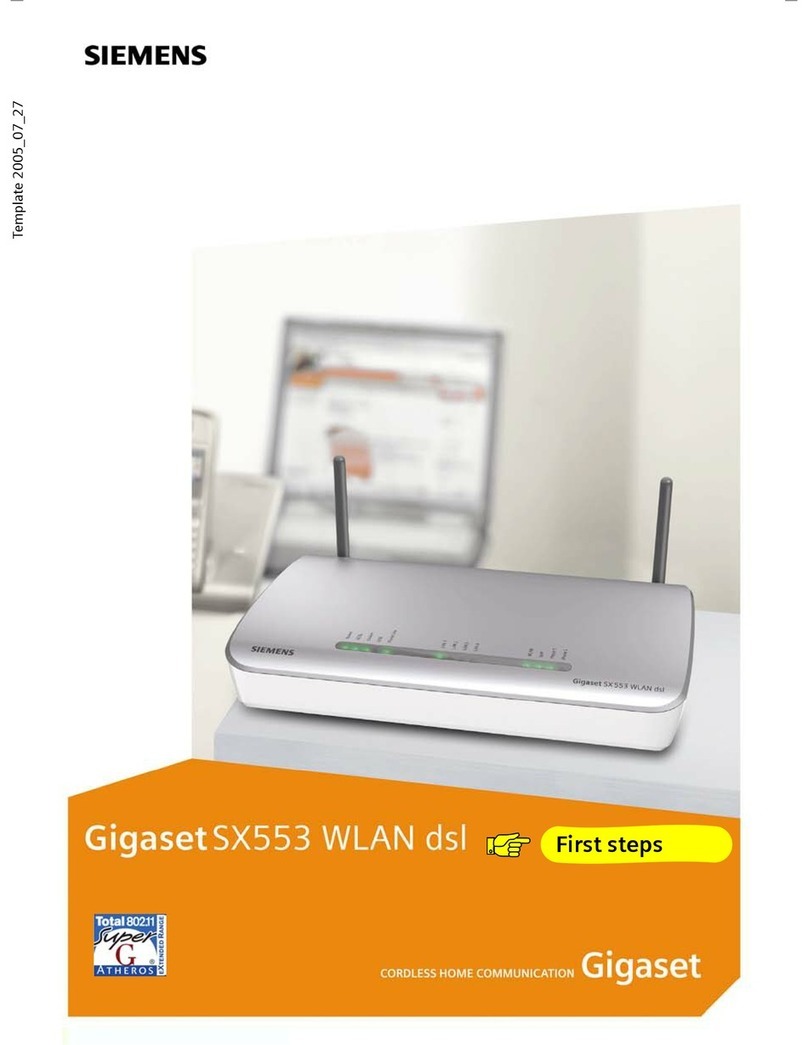
Gigaset
Gigaset Gigaset SX553 WLAN dsl User manual

Gigaset
Gigaset SX763 User manual

Gigaset
Gigaset gigaset SE551 User manual

Gigaset
Gigaset SX763 User manual
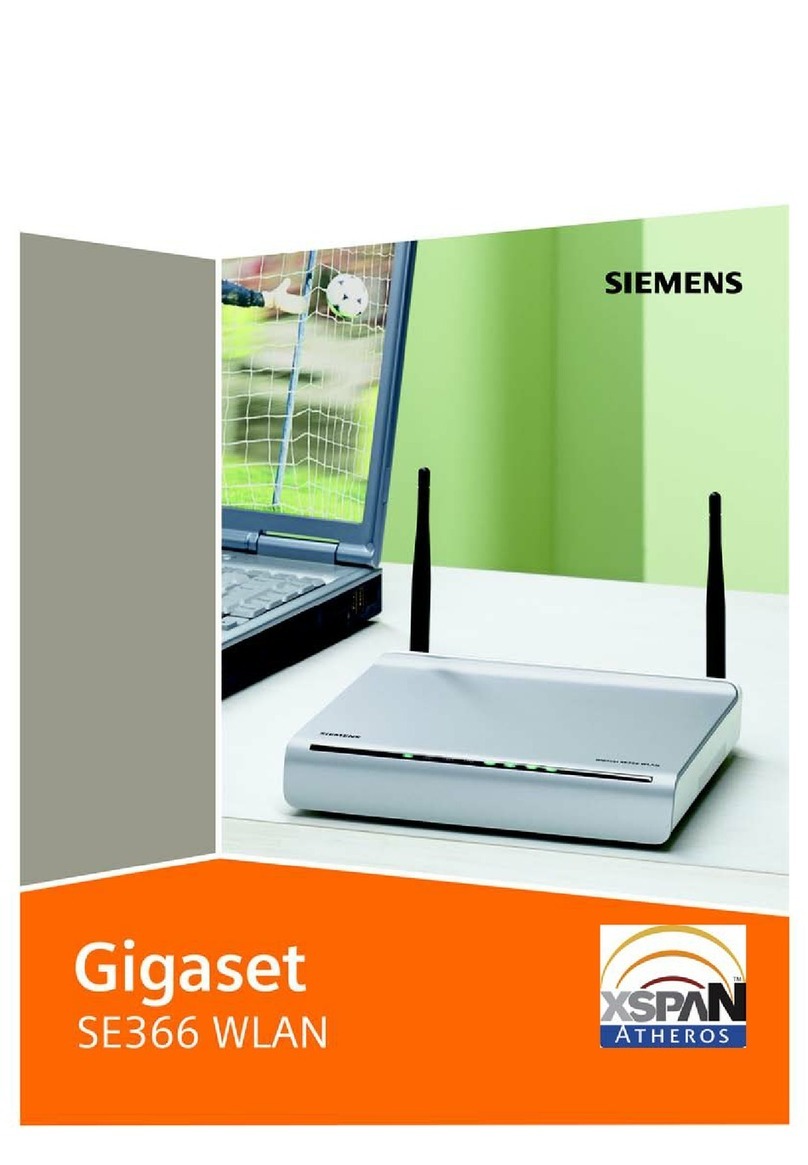
Gigaset
Gigaset SE366 User manual
